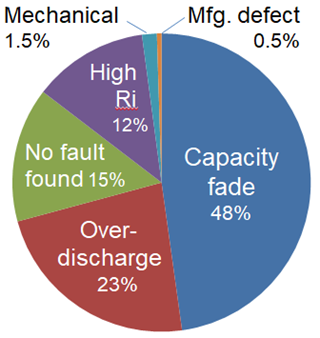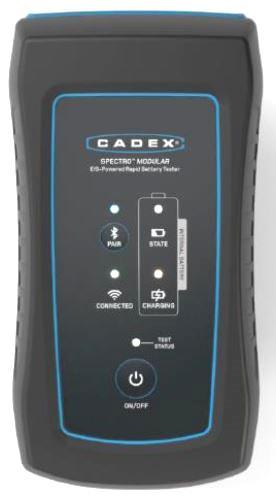Battery Management System (BMS)
Battery Management System (BMS)
Larger batteries, including all Li-ion, are managed by a BMS. This battery control ciruit monitors voltage, current and temperature of a battery, sets limits and detect anomalies. Typical iregularities are low voltage caused by cell failure and high internal resistance due to aging or sulfation of a lead acid. However, the most common failure mode, fading capacity, is not detected. Capacity loss continues unnoticed until the car does not start one morning when the capacity has managed to drop below 30%.
A battery is a black box that does not reveal its condition. It looks the same when fully charged or empty, new or faded. A car tire, in comparison, distorts when low on air and calls for replacement when the treads are worn. Advancement in Diagnostic Battery Management (DBM) with Spectro™ assesses capacity, the leading health indicator of a battery.

Failure analysis of 800 AGM starter batteries. Source: Johnson Control, Germany
A failure analyses by Johnson Control demonstrates capacity fade as the most common failure mode at 48%. Research by a German university further reveals that a modern BMS cannot detect capacity fade. Loss of energy occurs gradually as a function of wear-and tear without affecting voltage and internal resistance (Ri) readings significantly. Serving as a starter battery, capacity loss does not reflect in reduced performance while a rise in Ri slows cranking. in this analysis high Ri only accounts for 12% of failures..
The test-pool also includes user-induced faults caused by over-discharging at 23% and no fault found at 15%. Mechanical and manufacturing defects are at a low 2%. Battery manufacturers often carry the burden to replace a battery under warranty for no fault on the product. Better battery test methods are the answer.

Spectro Modular for monitoring
When fully developed, Spectro™ technology will also monitor standby batteries. Installed at a remote battery site, the Spectro Modular will monitor battery strings up to 48V with cloud connectivity to make battery test results visible to the fleet supervisor. Unlike competitive battery monitors that only check voltage, current and temperature, the Spectro Modular reflects the available runtime of the battery monitored. Our team is working on cloud analytics to also present the remaining useful life (RUL) as part of risk management in batteries..
Standby batteries cannot be installed and forgotten. The Spectro Modular will be of special interest to battery users relying on secured hours of runtime on a power failure. With the ability to read capacity, the fleet supervisor has runtime information with prediction when to replace the battery. This threshold is user-set on a minimal viable capacity need. The Spectro™ battery monitoring system offers a new level of risk management that is superior to date stamping and other test methods. Battery fade is governed by usage and environmental condition of which heat is a killer. Monitoring battery capacity optimizes service life and lowers the total cost of ownership while improving system reliability.
